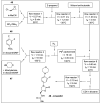Continuous-Flow Chemistry and Photochemistry for Manufacturing of Active Pharmaceutical Ingredients
- PMID: 36500629
- PMCID: PMC9738912
- DOI: 10.3390/molecules27238536
Continuous-Flow Chemistry and Photochemistry for Manufacturing of Active Pharmaceutical Ingredients
Abstract
An active pharmaceutical ingredient (API) is any substance in a pharmaceutical product that is biologically active. That means the specific molecular entity is capable of achieving a defined biological effect on the target. These ingredients need to meet very strict limits; chemical and optical purity are considered to be the most important ones. A continuous-flow synthetic methodology which utilizes a continuously flowing stream of reactive fluids can be easily combined with photochemistry, which works with the chemical effects of light. These methods can be useful tools to meet these strict limits. Both of these methods are unique and powerful tools for the preparation of natural products or active pharmaceutical ingredients and their precursors with high structural complexity under mild conditions. This review shows some main directions in the field of active pharmaceutical ingredients' preparation using continuous-flow chemistry and photochemistry with numerous examples of industry and laboratory-scale applications.
Keywords: active pharmaceutical ingredients; flow chemistry; photochemistry.
Conflict of interest statement
The authors declare no conflict of interest.
Figures
































Similar articles
-
Impact of continuous flow chemistry in the synthesis of natural products and active pharmaceutical ingredients.An Acad Bras Cienc. 2018;90(1 Suppl 2):1131-1174. doi: 10.1590/0001-3765201820170778. An Acad Bras Cienc. 2018. PMID: 29873673 Review.
-
Achieving continuous manufacturing: technologies and approaches for synthesis, workup, and isolation of drug substance. May 20-21, 2014 Continuous Manufacturing Symposium.J Pharm Sci. 2015 Mar;104(3):781-91. doi: 10.1002/jps.24252. Epub 2014 Dec 2. J Pharm Sci. 2015. PMID: 25470351 Review.
-
Raw material variability of an active pharmaceutical ingredient and its relevance for processability in secondary continuous pharmaceutical manufacturing.Eur J Pharm Biopharm. 2018 Jun;127:92-103. doi: 10.1016/j.ejpb.2018.02.017. Epub 2018 Feb 13. Eur J Pharm Biopharm. 2018. PMID: 29452241
-
Active pharmaceutical ingredient (API) production involving continuous processes--a process system engineering (PSE)-assisted design framework.Eur J Pharm Biopharm. 2012 Oct;82(2):437-56. doi: 10.1016/j.ejpb.2012.07.001. Epub 2012 Jul 20. Eur J Pharm Biopharm. 2012. PMID: 22820647
-
Continuous low-dose feeding of highly active pharmaceutical ingredients in hot-melt extrusion.Drug Dev Ind Pharm. 2016 Aug;42(8):1360-4. doi: 10.3109/03639045.2015.1135938. Epub 2016 Jan 24. Drug Dev Ind Pharm. 2016. PMID: 26755129
Cited by
-
Recent Advances in Electrochemical Sensors for Formaldehyde.Molecules. 2024 Jan 9;29(2):0. doi: 10.3390/molecules29020327. Molecules. 2024. PMID: 38257238 Free PMC article. Review.
-
From Batch to the Semi-Continuous Flow Hydrogenation of pNB, pNZ-Protected Meropenem.Pharmaceutics. 2023 Apr 23;15(5):1322. doi: 10.3390/pharmaceutics15051322. Pharmaceutics. 2023. PMID: 37242564 Free PMC article.
References
-
- Booker-Milburn K.I., Noel T. Flow Photochemistry. ChemPhotoChem. 2018;2:830.
-
- Elgue S., Aillet T., Loubiere K., Conté A., Dechy-Cabaret O., Prat L., Horn C.R., Lobet O., Vallon S. Flow photochemistry: A meso-scale reactor for industrial applications. Chim. Oggi. 2015;33:58–62.
-
- Beeler A.B. Introduction: Photochemistry in organic synthesis. Chem. Rev. 2016;116:9629–9630. - PubMed
-
- Urge L., Alcazar J., Huck L., Dormán G. Recent advances of microfluidics technologies in the field of medicinal chemistry. Annu. Rep. Med. Chem. 2017;50:87–147.
Publication types
MeSH terms
Substances
LinkOut - more resources
Full Text Sources

